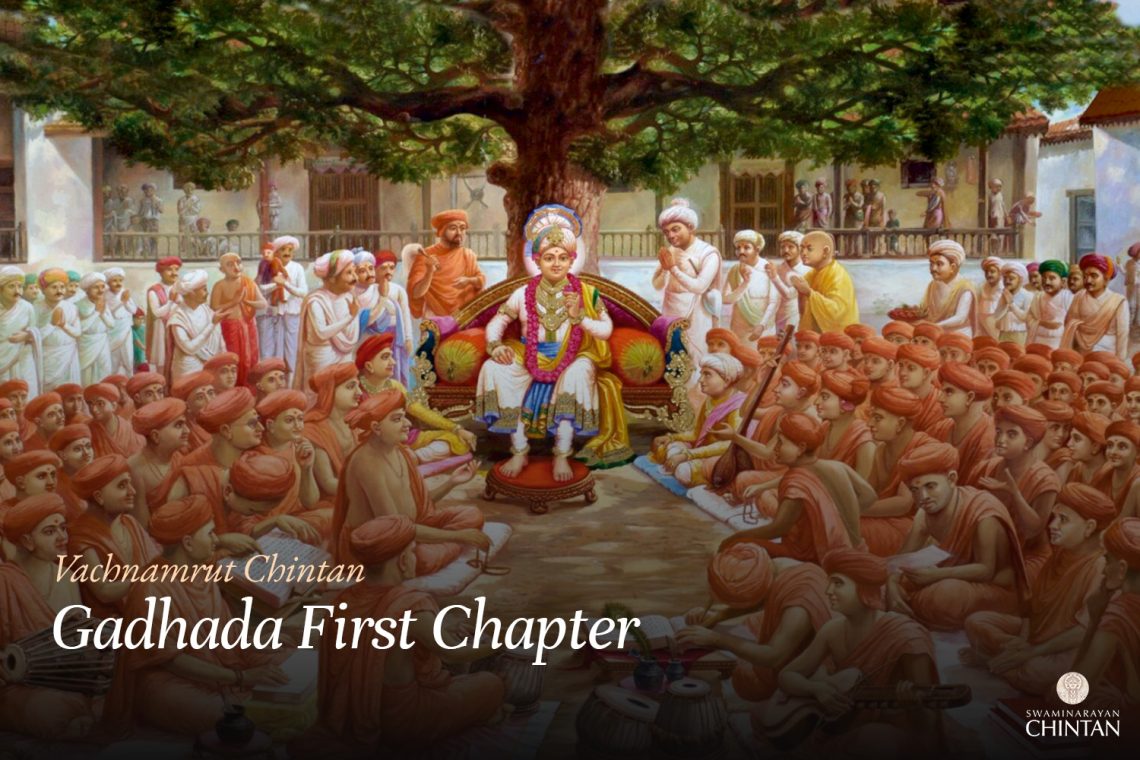Central Insights:
- Doing Satsang (association with saints) for the Ultimate Salvation.
Key Points:
- Who encourages and discourages one from fulfilling internal desires?
- Identifying the inner bad company (kusang) and the saint (sat).
- To reach ultimate salvation is the kind of Satsaṅg people need to strive for.
Explanation
Here Kakabhai from Rojka asks Nityanand Swāmi: “There is a voice within us that tells us to indulge in worldly desires and another that says to stay away from it. Who are these two?” Thereupon Nityanand Swāmi Answers: “The voice saying No is the soul and the voice saying yes is the Mind.” Shreeji Māharāj answers in a different manner. Shreeji Māharāj gives a very long response in the Vachanāmrut but its essence is that “the voice that encourages one to indulge in desires is Kusang (negative influences) and the voice that stops us is the Saint residing within.”
What can be discerned from this Vachanāmrut is that Nityanand Swāmi’s response was not wholly accepted by Shreeji Māharāj. After Swāmi responded Māharāj did not highlight it. If it were the complete answer then like many instances in the Vachanāmrut, Māharāj would have responded with “this is the complete answer” and would continue forward, but this was not the case here. However out of respect for Swāmi, or to acknowledge to a certain extent that it had some truth to it, Māharāj did not disagree with the response. In many cases Māharāj would say “that you have taken the other course” or would raise doubts in the response to show why the Saint’s response is wrong. This was not the case here. The response was given in a different manner.
Nityanand Swāmi’s argument’s weakness is that Māharāj says the mind is what drives the person towards desire, which is not the case. Māharāj says in Vach.G.M. 23 that “if we look at the mind, it is actually a part of the soul and not distinct from it. Additionally Vach,G,A. 6 says that “if the soul dislikes a topic it will not register with the mind, but if the mind likes something then it will persuade the soul”. Lastly, Vach.G.M. 63 Shreeji Māharāj says “when the soul has gained strength, the inner senses and the soul become one. Where the Antahkaran sticks, that’s where it will follow”.
This response by Swāmi in this manner demonstrates that mind is what encourages indulging in desire, whereas the soul is what discourages indulging in desire. This does not align with what Māharāj is saying. This is because if the soul says no then the mind cannot say yes. Hence Māharāj responded.
Maharaj has given a very beautiful answer. All the objects related to a person are of two types: some exist subtly in the heart, and others exist physically in their respective places. Just as the objects related to the five senses and ego exist physically in their respective places, they also exist subtly in the heart. The objects in the heart bind the soul more than the external objects do. For example, the bondage caused by a woman in the heart may be more obstructive on the path to liberation than an external woman. Conversely, divine objects related to God also exist both externally and subtly in the divine soul’s heart.
The image of God and His saints within the soul of the individual helps more than harbouring the images of other deities (Bhrahm Swarup). The internal Saint/Demon is coaxed by the external associations with Saints and negative influencers. The more and more the associations with Saints grow the more internally the stronghold of the Saint grows. As association with bad influence grows externally the same will happen internally. Bad influences will draw one towards worldly desires. Saints will do the opposite. In this manner the influence of a Saint or another individual is what determines the yes/no response that is experienced internally. Internally a Saint inspires love for God. Whereas negative influences will, after satisfying desires, instil attachments for vices. In this manner they both say yes and no.
Limited to this Vachanāmrut, it can be inferred that whoever drives a person towards fulfilling desires are negative influences even if these individuals are one’s parents. Māharāj uses this as an example in the Vachanāmrut. He also says that only a Saint will drive a person towards God. Māharāj gives the example of Mahabharata to instil courage. Whoever has God and His saints on their side will win any internal battle. Therefore, Shree Krishna says in the Gītā the following:
यत्र योगेश्वरः कृष्णः यत्र पार्थो धनुर्धरः।
तत्र श्रीर्विजयो भूतिर्ध्रुवा नीतिर्मतिर्मम।। (गीता १८.७८)
Yatra yogeśhvaraḥ kṛiṣhṇaḥ yatra pārtho dhanurdharaḥ
Tatra śhrīr vijayo bhūtir dhruvā nītir matir mama।।
(Gītā 18.78)
By giving the example of the warriors of a King, Māharāj demonstrates that one needs to fight against the internal negative influences.
Jasaka Bhai from Jasaka asked Nityanand Swami: How can one have unwavering faith in God? Swami replied that staying away from negative influences (kusangis) and having extensive association with saints fosters unwavering faith in God. However, Maharaj, sensing a shortcoming in this answer, graciously provided his own response.
Maharaj pointed out that even if one has extensive association with saints and stays away from negative influences, if one engages in satsang (spiritual association) with selfish desires or to fulfill worldly ambitions, it leads to obstacles in unwavering faith. Therefore, Shriji Maharaj stated that satsang should be performed for the welfare of one’s soul, meaning associating with saints should be aimed at strengthening faith. Only then does one attain welfare.
With this intention, if one extensively associates with saints and stays away from negative influences, unwavering faith can be achieved. Although taking refuge in God alleviates worldly suffering, if worldly pleasures are not destined for us, even our prayers might not be fulfilled by God. Therefore, one should engage in satsang without such expectations to achieve unwavering faith.
Glossary
| Antahkaran – Inner faculties |
| Kusang – Evil Association Association with individuals or ideologies that destroy faith in Bhagwan and devotion. |
| Sant – Saint |
| Yogeshwar – Master of yoga; supreme controller of all yogic powers In this Vachanamrut, Shreeji Maharaj refers to God as the true Yogeshwar—He is the source of all spiritual powers, the giver of liberation, and the one who controls everything. |

